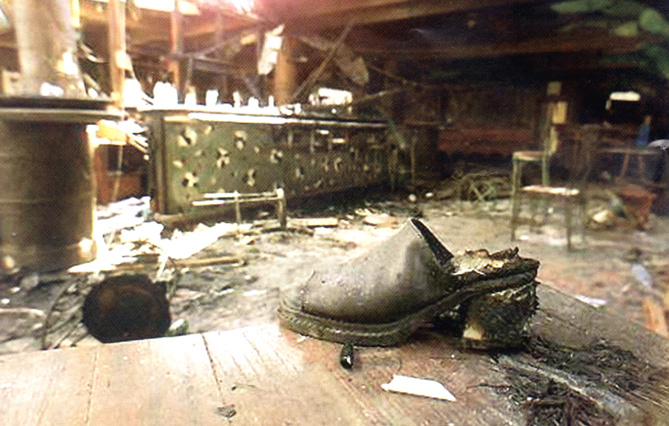Ten years on, one image remains burned into my consciousness - a char-blackened human arm still wearing an amazingly pristine silver watch.
In any other context this arm would not be recognisable. It's angular, misshapen and blacker than hell. It looks like part of a tree branch after a bushfire.
But it is an arm. It is protruding from a bucket full of body parts in the morgue at Bali's main hospital, Sanglah, in Denpasar.
Hours earlier it had been attached to a vibrant young Australian man who no doubt had been enjoying the holiday of a lifetime.
How is it possible to know this? Adam Condon, who helped identify teammates from Sydney's Coogee Dolphins rugby league team, says some corpses are wearing expressions of happiness, as if their last moment was frozen in time, joyful and carefree.
There were excruciating deaths, for sure. But for many victims the end came too suddenly to be felt or recognised. It is one comforting thought amid a nightmare of dancing demons.
But whose arm was it? Maybe the watch will help provide an answer.
There is no point airbrushing macabre images like this from history because they are part of the grim reality that confronted profoundly shocked families who came to this hospital 10 years ago to find out if their kids, their brothers, sisters, aunts and uncles, were still alive.
Or whether they were on the horrific death list that would eventually number 202, 88 of them Australians and three Kiwis.
On revisiting the morgue this week I bump into some of these family members and friends who are making the same cathartic journey. It's a comfort to chat with them, and I hope they feel the same.
I recall the gaunt, pale faces of a decade ago, hoping against hope they will not see something like that silver watch, or a birthday ring or pendant, or a familiar body piercing or tattoo on a body-less arm or foot, anything that will confirm their worst fears.
Most of them know the awful truth anyway. You can see it in their eyes. But they will not believe it until they see it, and in some cases they will not believe it even after they've seen it.
Adelaide couple John and Tracey Golotta do manage to identify their daughter, 19-year-old Angela. But they come back to repeat the process no fewer than four times - "just to make sure", to use their own words of heartbreak and disbelief.
Coping with grief seems unbearable at the best of times, but in such macabre surroundings it is surely too much to ask of anyone.
Sanglah's morgue is designed for a holiday island, not a terrorist atrocity. There are 10 refrigeration units, not 200.
So many mutilated bodies are piled up that the decomposing corpses themselves threaten to become a health hazard. Most lie in the outdoor heat of the tropics, wrapped in orange, yellow and white plastic bags. They form two long lines under a walkway.
Unattached body parts - and there are dozens - are kept in separate containers inside.
The stench is nauseating. Authorities have to rely on an ever-dwindling mountain of ice slabs to keep the bodies cold. They are also short of embalming fluid, and at one point even scalpels.
Scores of coffins lie in the grounds waiting to be filled.
There is no escape from this wall-to-wall grief, not even in sleep, for those few silent hours are also the time of nightmares.
The suffering of the families is raw and palpable and contagious. Some find comfort in talking, others don't. A hug, a look, a gesture seem the only means of conveying to these near-catatonic souls your empathy and compassion.
Some of the families talk volubly about those they have lost. Now and then they break down in tears, and when they do it is often while considering a seemingly innocuous question. How old was he? What was her name? Maybe it's the suddenness and brutality of the past tense. Maybe the devil is in those tiny but very personal details.
That whole fraught time is a blur of tears and pain, a mishmash of images.
And then there is the arm. It floats in my mind like the arm of the weighted-down corpse bobbing up above the water in the final scene of the movie Deliverance. Does that arm really rise, or is it just a bad dream? Who knows?
But this Bali arm is real. It has become for me a symbol of the indescribable pain of 202 families. Like their pain, it never completely goes away.
Thursday 11 October 2012
http://www.nzherald.co.nz/lifestyle/news/article.cfm?c_id=6&objectid=10839775


0 comments:
Post a Comment